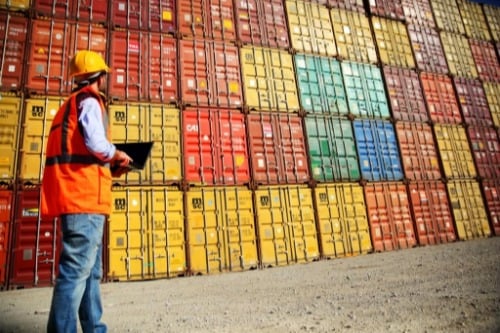Container terminals worldwide move hundreds of thousands of containers through their yards daily. In fact, large terminals may discharge or load between 8,000 and 10,000 units to the vessel, train, or through the gate. This work is all conducted with the labor force, management, and outside trucking companies spread throughout the yard to move cargo.
Production and safety are key elements to a successful container terminal operation. Over my nearly twenty years of experience managing terminal operations, the following five factors emerged as the having the greatest contribution to loss of life, injuries, and costly damage to cargo/equipment.
1. Blind Corners
Containers are being stacked higher than ever to maximize throughput. While there are industry safety rules in place to ensure a safe working environment, containers may block visibility. It is imperative that everyone involved in the operation manage blind corners regularly by not stacking containers at end rows adjacent to heavy traffic flow.
2. Speed/Breaking Distance
The over-the-road traffic rule of thumb is generally one car length for every 10 MPH. However, with cross traffic and heavy loads, operators at the terminal must drive more slowly. Operate at a safe speed. Rule 905 in the ILWU PCMSC (Pacific Coast Marine Safety Code) states that “operators shall have the vehicle at all times under control so it can be brought to an emergency stop in the clear space in front of the vehicle.”
3. Seat Belts
It only takes two seconds to secure a seat belt, yet it’s a constant challenge to ensure 100% compliance. When moving on rough surfaces, the belt may tighten, which can be uncomfortable. Operators may also feel it’s unnecessary to strap-in when traveling short distances. However, all it takes is one hit to cause serious injury.
4. Congestion
The size and ability of every terminal varies. Some are fully automated while some use a combination of technology and labor. Some may have on-dock or adjacent rail facilities. All these variables can affect how quickly cargo moves through the facility. As a result, operations teams work tirelessly to maximize production in the safest way without stand-by. Some effective ways to alleviate congestion include metering pick-up and/or delivery of contains through an appointment system. Well thought-out operational plans for the vessel, rail, and yard can also help maximize flow and minimize congestion. Established terminal traffic patterns are critical.
5. 5th Wheel Height/Turning Radius
Yard tractor operators regularly raise and lower their 5th wheel plate to connect or disconnect from containers on chassis/bombcarts. This efficient process can help maximize production by eliminating the need to manually wind the chassis legs up or down. The legs on bombcarts are typically fixed, making it necessary to jack the 5th wheel. However, if the 5th wheel remains high while backing into a parking stall, especially with 20’ containers, the container may fall over, creating a whip-like effect that often causes serious injury. It’s imperative that operators slow down while parking or pulling units, and straighten as much as possible.
These simple reminders can go a long way toward safer operations. Productivity is key, but going home at the end of that productive day is what really matters.


